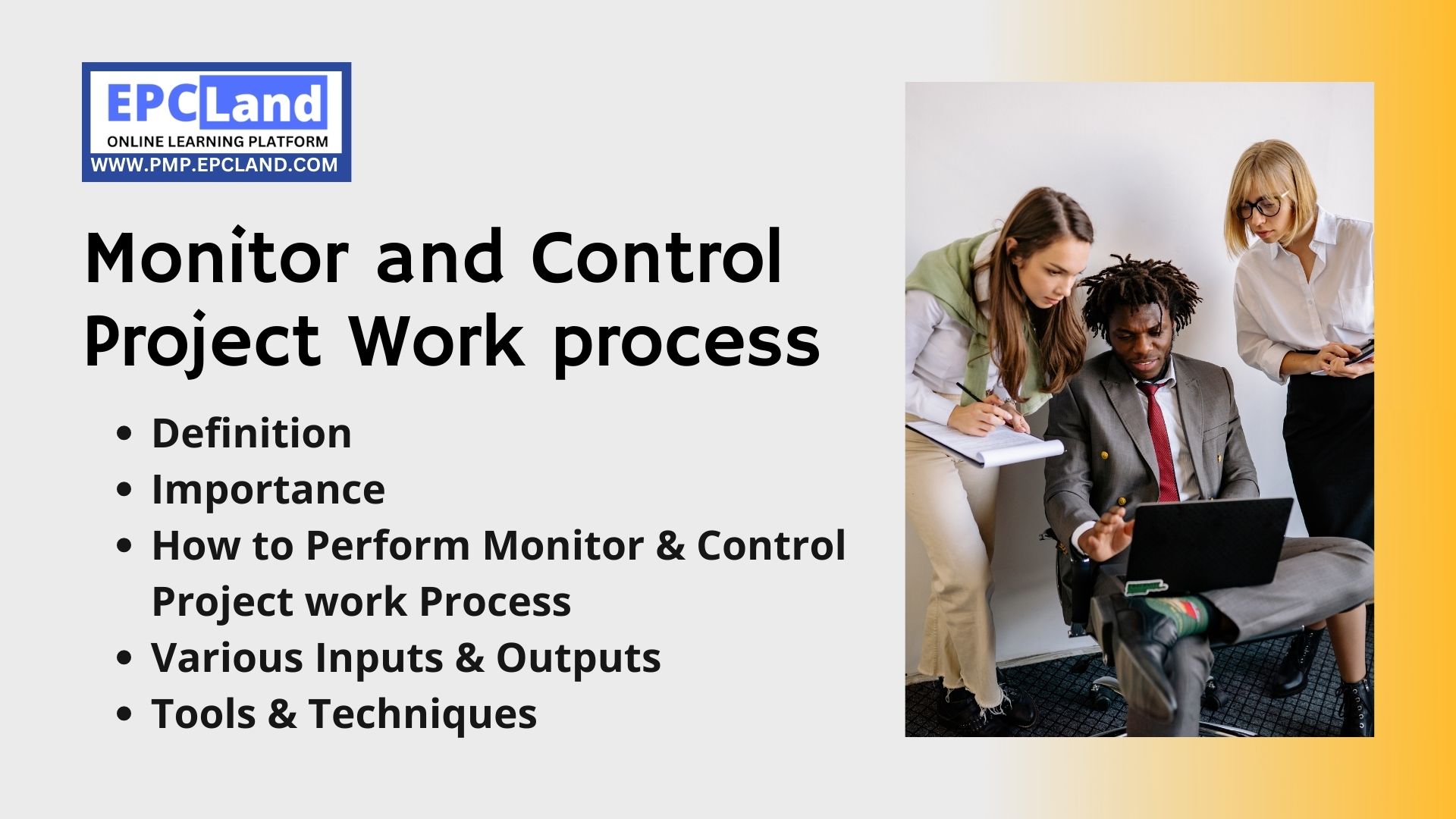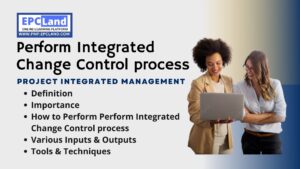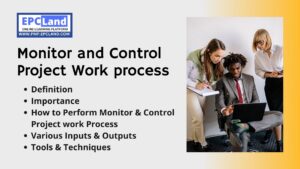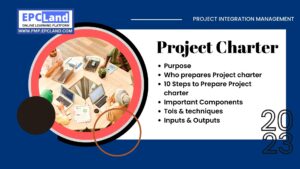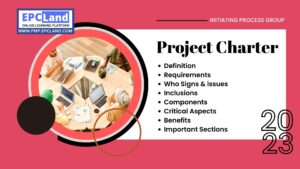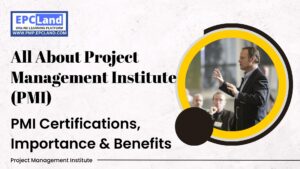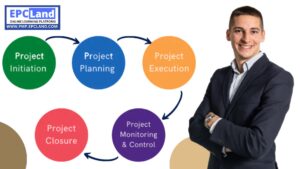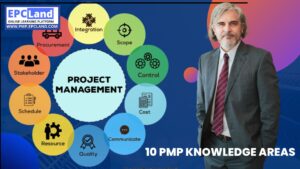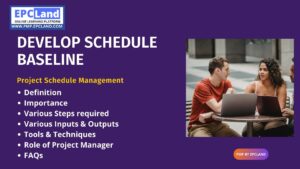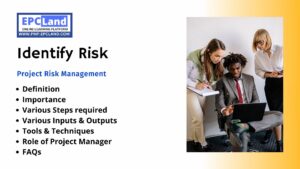Table of Contents
ToggleWhat is Monitor & Control project Work process
The Monitor and Control Project Work process is a project management process that involves monitoring and controlling the progress of the project work, and taking corrective action when necessary. This process helps to ensure that the project stays on track, and that any issues or deviations from the project plan are identified and addressed in a timely manner. The key activities of the Monitor and Control Project Work process include:
- Monitoring project performance: This involves regularly reviewing project performance data, such as schedule, cost, and quality metrics, to ensure that the project is on track and to identify any areas of concern.
- Identifying and analyzing variances: This involves comparing actual project performance to the project plan, and identifying any variances or deviations from the plan.
- Taking corrective action: This involves developing and implementing corrective actions to address any identified issues or variances, and to bring the project back on track.
- Managing changes: This involves managing changes to the project scope, schedule, or budget, and ensuring that all stakeholders are informed and involved in the decision-making process.
- Managing risks: This involves monitoring the project’s risks and implementing risk response plans to mitigate or avoid potential risks.
- Assessing project performance: This involves evaluating the project’s performance against the project plan and taking appropriate actions to address any issues that arise.
- Managing stakeholder engagement: This involves ensuring that stakeholders are informed of project progress and that their concerns and needs are addressed.
- Reporting project performance: This involves creating and distributing regular project performance reports to stakeholders to keep them informed of the project’s progress.
The outputs of the Monitor and Control Project Work process include performance reports, change requests, issue logs, and updated project management plan, and project documents updates.
Attempt Quiz-1 on Monitor & Control Project Work Process

Time's up
What is Importance of Monitor & Control project Work process
The Monitor and Control Project Work process is important for several reasons:
- Ensures project stays on track: By regularly monitoring project performance and taking corrective action when necessary, the Monitor and Control Project Work process helps to ensure that the project stays on track and that objectives are met.
- Identifies and addresses issues early: By identifying and analyzing variances and deviations from the project plan, the Monitor and Control Project Work process allows issues to be identified and addressed early, before they become major problems.
- Improves project efficiency: By managing changes and risks effectively, and by taking corrective action when necessary, the Monitor and Control Project Work process helps to improve project efficiency and reduce the likelihood of delays and cost overruns.
- Improves communication and stakeholder engagement: By regularly reporting project performance and managing stakeholder engagement, the Monitor and Control Project Work process helps to improve communication and engagement with stakeholders, and ensures that their concerns and needs are addressed.
- Facilitates continuous improvement: The Monitor and Control Project Work process helps to facilitate continuous improvement by regularly assessing project performance and capturing lessons learned, which can be used to improve future projects.
- Improves the quality of deliverables: By monitoring the project’s performance against the project plan, the Monitor and Control Project Work process helps to ensure that the quality of deliverables meets the project’s requirements.
- Provides visibility to project progress: By providing regular performance reports, the Monitor and Control Project Work process provides visibility to project progress and provides stakeholders with the information they need to make informed decisions.
Overall, the Monitor and Control Project Work process is an essential component of project management that helps to ensure that projects are completed on time, within budget, and to the satisfaction of all stakeholders.
How to perform Monitor and Control Project Work process
The Monitor and Control Project Work process involves several key steps to ensure that the project stays on track and that any issues or deviations from the project plan are identified and addressed in a timely manner. The steps include:
- Monitor project performance: Regularly review project performance data such as schedule, cost, and quality metrics to ensure that the project is on track and to identify any areas of concern.
- Identify and analyze variances: Compare actual project performance to the project plan, and identify any variances or deviations from the plan.
- Take corrective action: Develop and implement corrective actions to address any identified issues or variances, and to bring the project back on track.
- Manage changes: Manage changes to the project scope, schedule, or budget, and ensure that all stakeholders are informed and involved in the decision-making process.
- Manage risks: Monitor the project’s risks and implement risk response plans to mitigate or avoid potential risks.
- Assess project performance: Evaluate the project’s performance against the project plan and take appropriate actions to address any issues that arise.
- Manage stakeholder engagement: Ensure that stakeholders are informed of project progress and that their concerns and needs are addressed.
- Report project performance: Create and distribute regular project performance reports to stakeholders to keep them informed of the project’s progress.
To perform the Monitor and Control Project Work process, you will need to have a project management plan, a project schedule, a project budget, project performance metrics, a change management plan, a risk management plan, and other project documents in place. You will also need to use various tools and techniques such as performance reports, change requests, issue logs, and variance analysis to effectively monitor and control the project work.
Additionally, it’s recommended to establish a monitoring and controlling process that includes regular status meetings, project reviews, and performance metrics analysis, that will help to identify potential issues and allow you to take corrective actions to keep the project on track.
Regular communication with the project team and stakeholders is also important, keep them informed of project progress and address any concerns they may have in a timely manner.
What are tools & techniques for Monitor and Control Project Work process
There are several tools and techniques that can be used in the Monitor and Control Project Work process to help ensure that the project stays on track and that any issues or deviations from the project plan are identified and addressed in a timely manner. Some of these tools and techniques include:
- Performance reports: Create and distribute regular project performance reports to stakeholders to keep them informed of project progress and to identify any areas of concern.
- Change requests: Manage changes to the project scope, schedule, or budget, and ensure that all stakeholders are informed and involved in the decision-making process.
- Issue logs: Use an issue log to track and manage any issues or problems that arise during the project.
- Variance analysis: Compare actual project performance to the project plan, and identify any variances or deviations from the plan.
- Earned value management: Use earned value management techniques to measure project performance, including the schedule and cost performance.
- Control charts: Use control charts to identify trends and patterns in project data, and to help identify areas of concern.
- Project management software: Use project management software tools to help you manage and track project progress, schedule, budget, and other project data.
- Project reviews: Conduct regular project reviews to assess project performance and to identify areas that need improvement.
- Risk management: Use risk management techniques to identify, assess, and manage project risks.
- Configuration management: Use configuration management techniques to control project changes and ensure that all stakeholders are informed and involved in the decision-making process.
- Communication and stakeholders engagement: Regularly communicate with stakeholders and project team members and address any concerns they may have in a timely manner.
- Metrics and Key Performance Indicator (KPI) tracking: Use metrics and Key Performance Indicators (KPIs) to track project performance and identify areas for improvement.
It’s important to note that the tools and techniques used will depend on the nature of the project and the goals of the organization. It’s important to select the right tools and techniques that can be adapted to the context of the project.
Attempt Quiz-2 on Monitor & Control Project Work Process

Time's up
Inputs for the Monitor and Control Project Work process
The inputs for the Monitor and Control Project Work process include:
- Project management plan: The project management plan includes the project scope, schedule, budget, and other project-related information that is used to guide the project’s progress.
- Project schedule: The project schedule provides a detailed timeline of the project’s activities and milestones, and is used to track project progress.
- Project budget: The project budget provides a detailed breakdown of the project’s costs and is used to track project expenses.
- Project performance metrics: Project performance metrics, such as earned value, schedule performance, and cost performance, are used to measure project performance.
- Change log: The change log is used to track and manage changes to the project scope, schedule, or budget.
- Issue log: The issue log is used to track and manage any issues or problems that arise during the project.
- Risk register: The risk register is used to track and manage project risks.
- Configuration management system: The configuration management system is used to control project changes and ensure that all stakeholders are informed and involved in the decision-making process.
- Work performance data: Work performance data includes information about the progress of project tasks, deliverables, and activities.
- Deliverables: Deliverables are the tangible and intangible results of the project.
- Agreements, contracts, and policies: Agreements, contracts, and policies that are relevant to the project should be available to the team, as they can impact the project.
Outputs of the Monitor and Control Project Work process
The outputs of the Monitor and Control Project Work process include:
- Work performance information: This includes information about the progress of project tasks, deliverables, and activities.
- Change requests: Change requests are used to manage changes to the project scope, schedule, or budget.
- Project management plan updates: The project management plan may be updated to reflect changes to the project scope, schedule, or budget.
- Project documents updates: Project documents, such as the project schedule, budget, and performance metrics, may be updated to reflect changes to the project.
- Deliverable status: Deliverable status is used to track the completion of project deliverables.
- Recommendations for corrective or preventive actions: Recommendations for corrective or preventive actions to address issues or variances from the project plan are developed and implemented.
- Approved changes: Approved changes are implemented.
- Project performance report: A project performance report is produced and distributed to stakeholders to keep them informed of project progress.
- Forecasts: Forecasts are created to indicate the expected completion date, cost, and performance of the project.
- Organizational process assets updates: Organizational process assets, such as policies, procedures, and guidelines, may be updated as a result of the Monitor and Control Project Work process.
FAQs on "Monitor and Control Project Work" in Project integration Management
What is Monitor and Control Project Work in Project Integration Management?
It’s a process of regularly monitoring, reviewing and regulating project activities to ensure that project objectives are met, and corrective actions are taken if necessary.
What are the key activities in Monitor and Control Project Work?
- Performance measurement and reporting
- Progress tracking and updates
- Variance analysis
- Risk response planning
- Change control management
What is the purpose of Monitor and Control Project Work?
The purpose is to provide visibility into the project status, identify potential issues and take corrective actions to keep the project on track and meet its objectives.
How often should Monitor and Control Project Work be performed?
It depends on the size and complexity of the project, but generally, it should be performed on a regular basis, at least weekly or monthly.
Who is responsible for performing Monitor and Control Project Work?
The project manager is usually responsible for monitoring and controlling project work, but team members, stakeholders, and project sponsor may also play a role.
What tools and techniques are used in Monitor and Control Project Work?
- Earned value management
- Project management software
- Status meetings and progress reports
- Change control boards
- Variance and trend analysis
What are the benefits of Monitor and Control Project Work?
- Helps to keep the project on track
- Provides early warning of potential problems
- Helps to ensure that project objectives are met
- Increases visibility into project performance
- Supports effective decision-making and risk management.
Don’t Miss the 1000+ MCQ questions & hundreds of quizzes on PMP Knowledge Areas and Various important sections.
Similar Articles on Monitor and Control Project Work process
Add Your Heading Text Here
Lorem ipsum dolor sit amet, consectetur adipiscing elit. Ut elit tellus, luctus nec ullamcorper mattis, pulvinar dapibus leo.
Add Your Heading Text Here
Lorem ipsum dolor sit amet, consectetur adipiscing elit. Ut elit tellus, luctus nec ullamcorper mattis, pulvinar dapibus leo.
Add Your Heading Text Here
Lorem ipsum dolor sit amet, consectetur adipiscing elit. Ut elit tellus, luctus nec ullamcorper mattis, pulvinar dapibus leo.
Add Your Heading Text Here
Lorem ipsum dolor sit amet, consectetur adipiscing elit. Ut elit tellus, luctus nec ullamcorper mattis, pulvinar dapibus leo.
Add Your Heading Text Here
Lorem ipsum dolor sit amet, consectetur adipiscing elit. Ut elit tellus, luctus nec ullamcorper mattis, pulvinar dapibus leo.
Add Your Heading Text Here
Lorem ipsum dolor sit amet, consectetur adipiscing elit. Ut elit tellus, luctus nec ullamcorper mattis, pulvinar dapibus leo.
Add Your Heading Text Here
Lorem ipsum dolor sit amet, consectetur adipiscing elit. Ut elit tellus, luctus nec ullamcorper mattis, pulvinar dapibus leo.
Add Your Heading Text Here
Lorem ipsum dolor sit amet, consectetur adipiscing elit. Ut elit tellus, luctus nec ullamcorper mattis, pulvinar dapibus leo.
Add Your Heading Text Here
Lorem ipsum dolor sit amet, consectetur adipiscing elit. Ut elit tellus, luctus nec ullamcorper mattis, pulvinar dapibus leo.
Add Your Heading Text Here
Lorem ipsum dolor sit amet, consectetur adipiscing elit. Ut elit tellus, luctus nec ullamcorper mattis, pulvinar dapibus leo.
Add Your Heading Text Here
Lorem ipsum dolor sit amet, consectetur adipiscing elit. Ut elit tellus, luctus nec ullamcorper mattis, pulvinar dapibus leo.
Add Your Heading Text Here
Lorem ipsum dolor sit amet, consectetur adipiscing elit. Ut elit tellus, luctus nec ullamcorper mattis, pulvinar dapibus leo.
